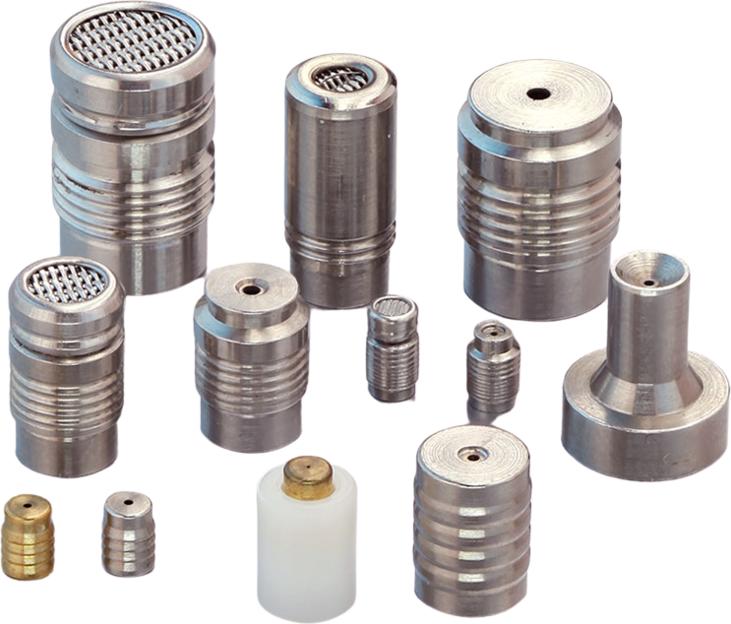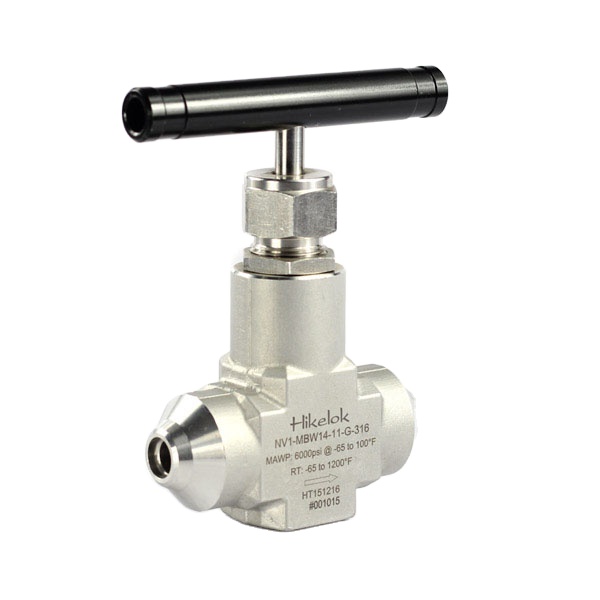
Constant Mass Flow in Oxygen Rebreathers
This part with the theory of oxygen rebreathers deals with the technical principle of a constant mass valve. This type of oxygen injection is widely used in breathing systems for oxygen, nitrox and trimix. Because this article is only about oxygen systems I limit myself in this article to these backgrounds.
A CMF system, sometimes also called a KISS (Keep It Simple Stupid!)system, determines the dosage of oxygen by restriction in a piece of stone or hard metal.

Another much used technique is to make use of a needle (metering) valve.

The orifice is a “synthetic ruby” (actually is “synthetic corundum”, Al2O3, the red variety is “ruby”, the blue variety is “sapphire”), not a natural gem (it would cost too much to cut a natural gemstone).(Info thanks to Gilberto Bonaga, with thanks!)
The use of corundum is due to the fact that it is the harder material after the diamond in the mohs scale and it is possible to produce it op industrial scale at a relative low price.
It is a matter of fine-tuning in such way that the dosage is slightly under the metabolic usage of the diver and only manual correction of the oxygen partial pressure is needed.
In this article I would like to further go into the measurements and choice of orifices.
The question is to determine how a CMF system works. From Jan Jahns article we learn the following:
Gas from a cylinder is reduced by a first stage regulator. The intermediate pressure is brought to a very small part in which a restriction hole has been drilled. This component is called an orifice. Gas laws stipulate that in certain conditions the quantity of gas (mass) remains constant. We can therefore inject a fixed mass of gas to the breathing loop of a rebreather.
Since at certain exertion the human body uses the same amount of oxygen at every depth, the quantity of oxygen we have to inject is not depth-related.
The gas mixture composition(when we dive deeper with mixtures) therefore is not determined by the amount of oxygen we need, but by its partial pressure and by the narcotic effect of inert gasses such as nitrogen. To diminish the narcotic effect of nitrogen and therefore the decompression obligation, we may enlarge the oxygen dosage to a maximum partial pressure of 1.6 bar (military limits 2.0 bar).
If we intend to exceed the depth that is determined by nitrogen sensitivity, helium is to be added (END).
How to choose the right orifice for a certain gas mixture?
A basic example:
Here with the general formula for CMF orifices in a simplified fashion:
Dn= d2.p0 .A
Where:
Dn = flow in l/min from the nozzle
d = orifice diameter in mm
P0 = intermediate pressure in bar
A = gas constant for Oxygen = 8.65
When we use a first stage with an intermediate pressure of 12 bar and we want a constant oxygenflow of 16 l/min the orifice diameter can be calculated:
16 l/min = d2 x 12bar x 8,65 –> 16 = 103,8d2 d2=0,15414 d =0,4 mm
In this type of calculation with oxygen, the diving depth is not yet very relevant because the flow is constant until the depth corresponding to half the intermediate pressure. In this case 12bar.a will occur at a depth of 110meter. The constant flow also called sonic flow will occur up to a depth of 55 metres. After this the flow becomes subsonic. Because we are dealing with an oxygen system, we will not dive deeper than 6 metres and there will be no change in the gas flow.
If, after reading this article, you are interested in the theory behind these orifices and nozzles, there is a page where the theory is explored. HERE

Therebreathersite was founded by Jan Willem Bech in 1999. After a diving career of many years, he decided to start technical diving in 1999. He immediately noticed that at that time there was almost no website that contained the history of closed breathing systems. The start for the website led to a huge collection that offered about 1,300 pages of information until 2019. In 2019, a fresh start was made with the website now freely available online for everyone. Therebreathersite is a source of information for divers, researchers, technicians and students. I hope you enjoy browsing the content!
